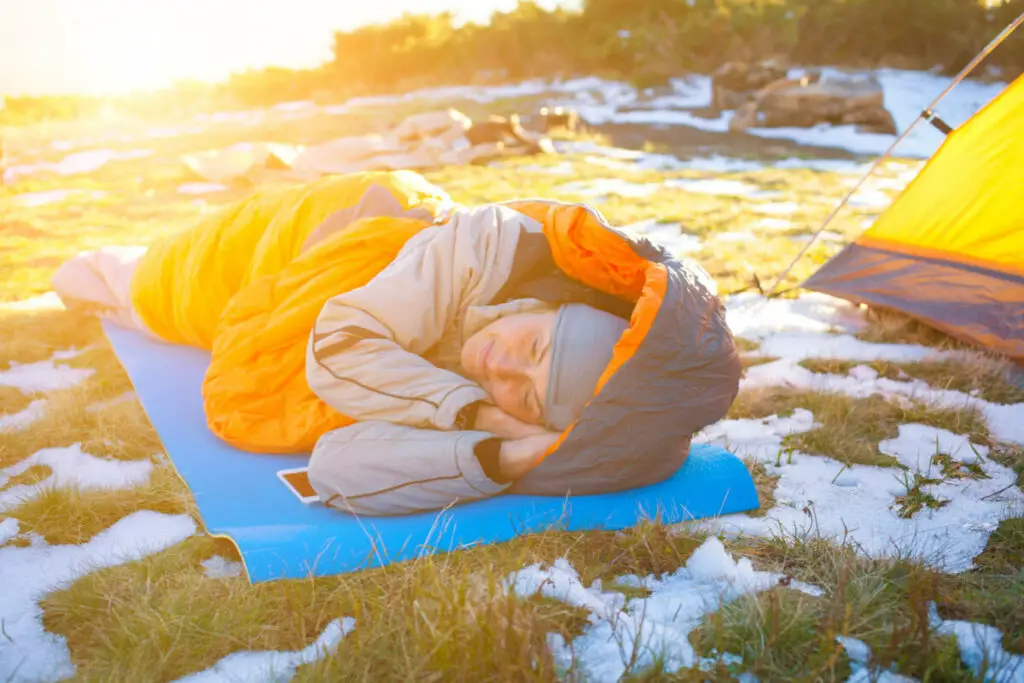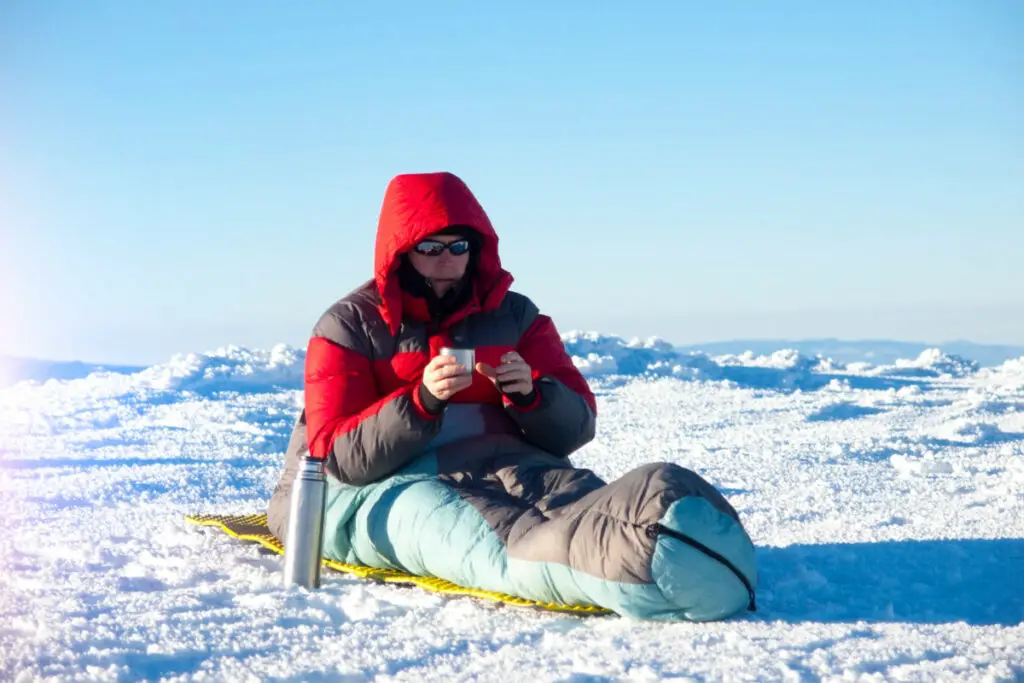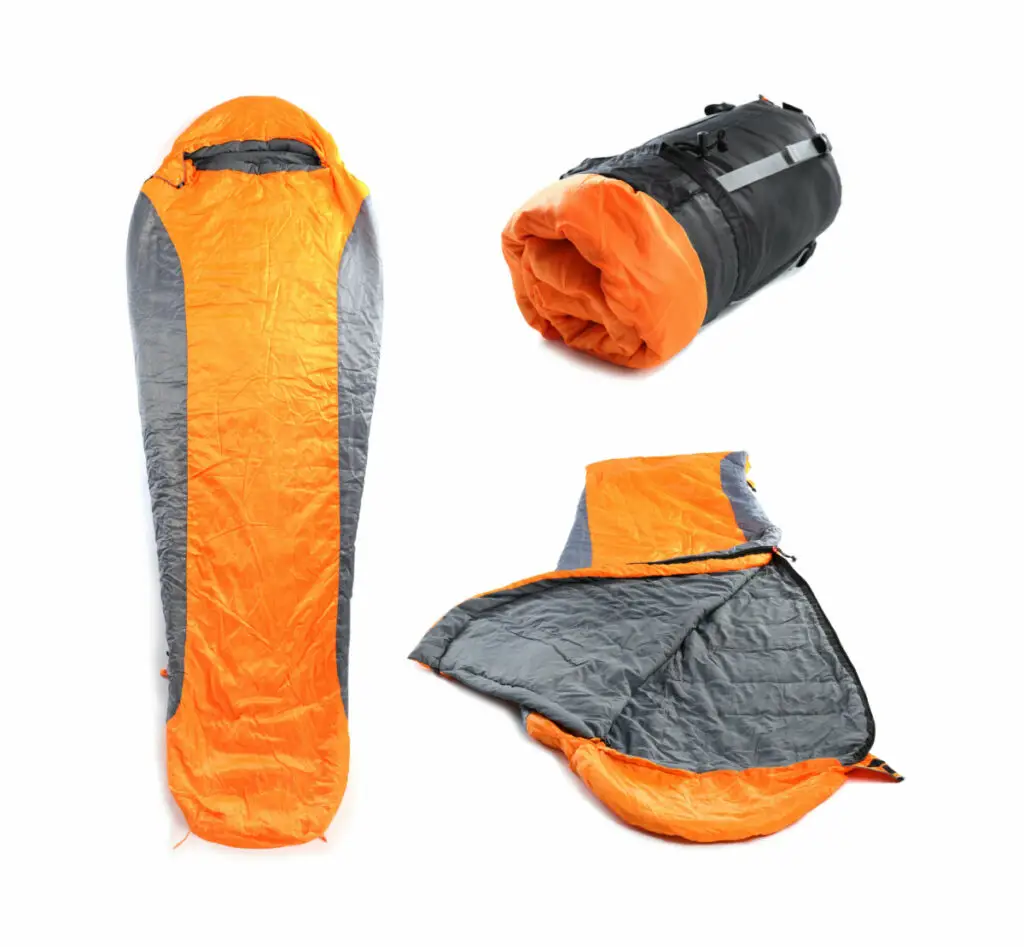
Are you planning a camping trip or a backpacking trip? Are you looking for a new sleeping bag and are not quite sure where to start? Making sure you choose the right sleeping bag can be intimidating, but this post can give you some tips on how to feel more at ease when choosing a sleeping bag to have the best experience possible out there.
When buying a sleeping bag, determine the temperature range needed and if it is packable. Down sleeping bags are better for backpacking trips, while synthetic bags are more affordable. Consider other features that might be useful like the zipper, hood, shape, and size of the bag.
To learn more about what you need to know about choosing a sleeping bag, keep reading.
Location and Temperature Considerations

Perhaps the most important factor when buying a sleeping bag is where and when you will be using it. If you are planning on ice caving in the winter, you will obviously need a specialized bag. The same goes for warm conditions. Luckily, sleeping bags have a temperature rating that can help you decide which one is right for you.
If you have already been on the hunt for sleeping bags, whether that be online or in an outdoor store, you may have noticed that somewhere on the sleeping bag label or on the description of the sleeping bag there is a temperature number listed in either Celcius or Fahrenheit. This information has a purpose that can help you determine which sleeping bag to get over another one. When a temperature is listed on a sleeping bag label, it is describing the lowest temperature you could use that particular sleeping bag in and remain comfortable. Not warm, necessarily, but comfortable.
In addition to the degree that is listed on the label, the ranges of degrees are put into 3 different categories: summer, 3-season, and winter. In a summer sleeping bag, the lowest temperature you can take it in is 35°F and higher. A 3-season sleeping bag can be used in temperatures ranging from 15°F to 30°F and higher. Winter sleeping bags can be used in temperatures ranging from 0°F to 10°F and higher. (Source)
The season should not be the only determining factor when considering which temperature of the sleeping bag to choose. You should also make sure to check the weather and temperature predictions for the period of time you will be out backpacking, hiking, or camping in that area. Oftentimes when traveling in places with a higher elevation, it can get much colder than what you experience at your current elevation during the night, so taking that into consideration will help you avoid making an uninformed purchase regarding the temperature of your sleeping bag. When in doubt, go colder.
Insulation Type
After determining where you will be camping and checking the weather for the area, you can choose a sleeping bag with the correct insulation. There are two options for sleeping bag insulation: synthetic insulation or down.
Synthetic is going to be by far the better option if you are trying to purchase a good quality insulated sleeping bag but aren’t wanting to break the bank in doing so. It is also a great option if you are planning on camping in a humid climate or swampy area, as the synthetic insulation doesn’t absorb water. The downside to synthetically insulated sleeping bags is that they are on the heavier side and may weigh down your pack more than is necessary when backpacking. This would be a better option for camping.
If you are backpacking and want a lightweight, compactable sleeping bag, using a down sleeping bag is the best option. Depending on how often and rugged your backpacking trips are, down sleeping bags can last for a while. Down sleeping bags are known to be better at retaining heat than synthetic sleeping bags, so if you are backpacking in colder temperatures, pack a down sleeping bag to help keep you warm. While down is more expensive than synthetic, paying a little more money to make sure you are sufficiently warm should be worth it. (Source)
Types of Sleeping Bags

You will see several different designs of sleeping bags with different shapes. The wrong shape can make your night outdoors uncomfortable.
Shape
When we imagine a sleeping bag, many of us immediately think of the traditional rectangular shape that many people typically use. There is the rectangle shape, and, in addition to that, there are 3 other shapes including the semi-rectangle, mummy, and double. (Source)
Some may question the importance or significance of how the shape of your sleeping bag affects its effectiveness. When you are sleeping in a sleeping bag, you are essentially sleeping within one piece of fabric, rather than however many layers you have on your bed at home. Because the setup is a little different, it can affect your comfortability.
The recommended way to determine what shape you should be looking for in a sleeping bag is to actually go to an outdoor store and test each sleeping bag to get a feel for which shape is most fitting and comfortable for you. This way you get to become more familiar with what you like and what you don’t like in regards to how a sleeping bag fits and feels. (Source)
In the case you don’t have a physical store near you, here are some breakdowns of each shape:
Rectangle: The rectangle shape, when you are in the correct sizing for your height and weight, should have plenty of room for your arms and legs to feel comfortable and not cause any feelings of claustrophobia.
Semi-rectangle: The semi-rectangle is a happy medium between the rectangle shape and the mummy shape. It is a little more fitted than the rectangle but still allows movement for your arms and legs. This bag is good for cooler temperatures for those who can’t handle the restrictiveness of the mummy bag.
Mummy: The mummy shape is for those of us who don’t mind feeling snug and secure in our sleeping bags. This is a more fitted sleeping bag, so there is little excess room for your arms and legs to move around like they are in the rectangle and semi-rectangle. This type of bag is also ideal for below-freezing temperatures. Because it is slimmer, it better retains your body heat, keeping you warmer at night.
Double: The double sleeping bag is more geared towards those who sleep with a partner. With two people in one double sleeping bag, the room is comfortable, but not overly filled with room to move around too much.
Sleeping Bag Sizes
Finding the right size sleeping bag is an easy process. It is all dependent on your height. If you get a sleeping bag that is too short for you, that can restrict the insulation and make it less effective. If you get a sleeping bag that is too long or big for you, that can let air in and create a draft to let all of your body heat out of the sleeping bag.
Most sleeping bags come in regular and long sizes for both men, women, and youth.
| Bag Size | Length | Person’s Height |
|---|---|---|
| Men’s Regular | 78 inches long | Fits someone up to 6 feet tall |
| Men’s Long | 84 inches long | Fits someone up to 6 feet and 6 inches tall |
| Women’s Regular | 72 inches long | Fits someone up to 5 feet 6 inches tall |
| Women’s Long | 78 inches long | Fits someone up to 6 feet tall |
There are also sleeping bags designed for younger kids or youth. Most youth bags are designed for those shorter than 60 inches, or 5 feet of height. Keep in mind that your kids won’t be kids forever! You might as well purchase them an adult-sized bag that they can grow into. But remember that dead space in the bag means less retention of body heat. You can adapt an adult bag for your child by stuffing an extra blanket or clothing in the excess space at the bottom of the bag. You could also buy them a sleeping bag liner which is cheaper than a new sleeping bag. (Source)
Size also matters not only in the length of the sleeping bag but also when choosing the shape. People with broader shoulders would be more comfortable in a mummy bag, which is roomier at the top and more fitted at the bottom. This can be helpful in making sure you don’t feel restricted either in length or width.
Sleeping Bag Features
Sleeping bags come with all types of bells and whistles, but you may not need all of them. In fact, only choose a sleeping bag with special features that you know you’ll use.
Hoods
The purpose of a hood on a sleeping bag is to add another element that will help retain heat and keep you warm within the sleeping bag. (Source)
If you are going to be camping or backpacking in cold temperatures, you will most likely want a hood on your sleeping bag. That means you would choose from either a semi-rectangular sleeping bag or a mummy sleeping bag. If you already know you are planning on sleeping in cold temperatures, the mummy sleeping bag may be the one you want to choose because that will be the best to keep you warmest. The main point between the two is the hood element.
In referring back to choosing a sleeping bag that is most comfortable for you to move around in, when trying out hoods in particular, you will want to make sure the hood is not too tight around your head, but snug enough to keep the heat in. If your hood is too tight, it will not be comfortable to sleep in, and if your hood is too loose, it won’t be doing its job properly. This is also important so your head isn’t put in a position where you are breathing into your sleeping bag and letting moisture inside which can make it damp.
Zippers
Zippers on sleeping bags can be extremely difficult to work with. Zippers are an important thing to consider for your sanity when choosing a sleeping bag. Most of the time, even when you purchase a good quality sleeping bag, the zipper can still give you issues even though you spent a significant amount of money. When looking at the zipper on a sleeping bag, you are going to want a big, chunky, and heavy-duty zipper. If the zipper looks flimsy and delicate, then the chances are high that it will cause you major issues soon after purchasing.
Another tip when analyzing the zipper on a sleeping bag is to pay attention to what side of the sleeping bag the zipper is on. If you are right-handed, you are going to want to choose a sleeping bag with a zipper on the right side. If you are left-handed, you are going to want to choose a sleeping bag with a zipper on the left side. This is simply just for ease of use because it can sometimes get uncomfortable using the opposite hand to try and reach over the entire sleeping bag to zip it up.
Waterproof Shell
When we addressed insulation, we briefly went over how synthetic insulated sleeping bags are great for sleeping in humid climates because they don’t absorb water. If you are thinking that you might be facing some serious weather like rain or snow, you might also consider purchasing a waterproof shell for your sleeping bag, or a bag that has a waterproof exterior already.
Understand that there are down sleeping bags that you can add a shell to to make them more waterproof, but be aware that if that shell’s integrity is compromised at any point and allows any moisture in, the sleeping bag is going to have a very hard time drying out because of the water that has now absorbed into the insulation. (Source)
That is not the only downside of adding a shell to a down sleeping bag. Purchasing shells separately is expensive. It would save you a lot of money to purchase a sleeping bag that already has a shell on it.

